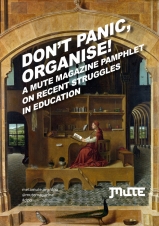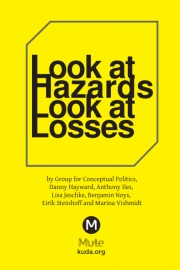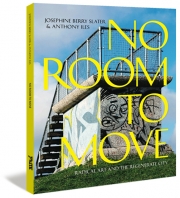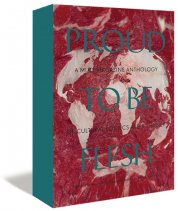The Future Isn't What it Used to Be
Tackling the conundrum of the future's relationship to the present through the prism of digital culture, this year's Transmediale festival strayed into some chaotic philosophical territory. In her review, M. Beatrice Fazi dismisses conceptions of the future as linear effect of the present, instead embracing models of ‘atemporality' and untimeliness
From the main stage of Transmediale, Berlin's annual international festival for art and digital culture, one of the keynote speakers, information technology businessman Conrad Wolfram, tells an anecdote: ‘My four-year old daughter enjoys making paper laptops by folding a sheet, drawing a screen on the top and a keyboard on the bottom. I asked her,' he continues, ‘"When I was your age I didn't make paper laptops. Why do you think that was?" After one or two minutes of reflection she said "No paper?"' The audience laugh.

Image: Ryoji Ikeda, 'data.tron', 2007. Photo: Ryuichi Maruo
Most, if not all of the people in the auditorium were able to find the humour in this little anecdote. They could, in fact, trace back a chronology of materials and inventions according to which technological developments in media and communications have eventually resulted in the specificity of our fast-paced, hyper-tech and very digital times. The joke, however, showed that this will not always be the case. At some point, the contemporary experience of the ‘technologically new' can and will, if not for age reasons, be thought as a given. The 23rd Transmediale festival chose to investigate exactly this nexus of presents, pasts and futures. Under the captivating slogan of ‘Futurity Now!', the event sought to expand the question about technological temporality through a varied and rich programme of exhibitions, talks, performances, screenings and workshops. This choice of topic was opportune since for last couple of years what has become one of the main European, new media events opted to focus on the rather worn out analysis of the apocalyptic fringes of technological ubiquity. These debates have sometimes got stuck in paralysing conspiracy paradigms, running the risk of flattening the complexity and urgency of contemporary socio-political and environmental situations into simplistic, well rehearsed templates. In the 2010 edition Transmediale proposed instead a somewhat broader and less explored theoretical agenda, bringing to the fore a critique of the critique itself. Or, in the words of the event's press release, ‘an era beyond futurist rhetoric, interwoven with the unstable and complex web of economic, political and cultural systems dependent on being perceived as "future worthy" without having been there yet.'
‘Futurity' is an interesting concept. It doesn't equate to the future, nor is it a function of it. Rather, futurity stands for the possibilities and qualities of being in the future. Futurity is an idea, a speculation of what is yet to be. It makes sense only when carried out in the very moment of the now. In this respect, it looks like one of those Polaroid pictures that have come back into fashion lately. You take a picture of a present that has already passed, the result of which you can only glimpse, whilst waiting for the photographic chemicals to settle and reveal the full, and yet always imperfect, image. In other words, futurity is not a strict and systematic prediction, nor a roulette bet placed on a random lucky number. Rather, it is a very conditional, human and contemporary venture; a critical practice of the present moment that aims to jump beyond those temporal limits that are nevertheless acknowledged to be constitutive and essential.
Enough with the cheering consensus of the 1990s. Enough with the exhausted and exhausting lament of the 2000s. In a sort of reworking of Kennedy's famous dictum, Transmediale.10's ‘Futurity Now!' wanted to prompt the motto: do not ask what the future has in store for you, but what you have in store for the future. But can we really strip any question concerning technology of its eschatological drives? And, most importantly, should we? If the rise and diffusion of the post-industrial information society is said to be established through technological determinism (i.e. the belief that technology, for good or bad, leads the development and shape of society, culture and politics), how can we now think of the unexplored potential of machine culture without ‘cutting and pasting' a kind of cause-and-effect master explanation from the present onto forthcoming circumstances? While this seems to be, more or less implicitly, the question Transmediale.10 intended to engage, it is not exactly clear whether the declared need to ‘understand' the future isn't also an assumption based exactly on the prediction that imminent and radical socio-cultural changes are moving ‘ahead', and at a speed dictated by an all encompassing, evolutionary principle of technological progress.

Image: Ken Rinaldo, 'Paparazzi Bots', 2009. Photo: Ken Rinaldo
From this perspective, the work selected for Future Obscura, the main art exhibitions of the festival, sketched a picture of the yet to come that seemed to reiterate much of the existing canon on contemporary ‘digital culture'. Make no mistake, the exhibited artworks are beautiful and technically clever. You can't help but be blinded by the lights of Ryoji Ikeda's data.tron, a massive audiovisual installation where the white light pulsing from the screen evokes the white noise of a malfunctioning electronic device. The visualisation of contemporary flows of information is impressive: each pixel of the large-scale work is algorithmically ‘tuned' and the mathematics underpinning the digital life is ‘embodied' in sounds and lights.
In a similar spirit, TeZ's Optofonica Capsule invites us to enter a shell-shaped device that gives the viewer/listener the chance to be surrounded by audiovisual artworks. The capsule's helmet is made of a special material permitting the diffusion of sound without using traditional speakers, while low frequencies are fed from a specifically designed floor up into the skeleton, intensifying the perceptual experience of vibrations.
Paparazzi Bots, by Ken Rinaldo, attracted much attention. In between a cameraman and a camera itself, the robotic creatures pick a person to photograph and, moving at human pace, follow and digitally capture the target. The image is then networked through online distribution platforms, making the photographed subject an instantaneous celebrity.
The collaborative project, Advertiser, by Julian Oliver, Clara Boj, Diego Diaz and Damian Stuart questioned a similar universe of visual overexposure. This work envisions a near future in which advertising in public environments can be selectively screened out and replaced by art. The improved-reality handheld binoculars track advertising spaces and transform them into artworks. The city becomes a newly revealed blank canvas which can be explored via the use of the binocular device.
Space constraints do not permit me to describe all the 11 works presented at the House of World Cultures. It is possible to venture, however, that a rhetoric of future sensory augmentation underpinned most of the exhibition. Future Obscura manifestly chose to engage with the socio-cultural conditions of futurity ‘through the lens of image-making'. In this respect, the visitor is presented with an imaginarium of technologically pervasive enhancement, thanks to which the informational structure of reality will become clearer and more evident. We could picture spaces illuminated by wireless radio signals (Fischer, Sjölén and Haque's Panoramic Wifi Camera), or imprint the invisible yet inescapable radiation of nuclear disasters (Alice Miceli's Chernobyl Project - The Invisible Stain). This technologically enhanced vision, though, can be said to be partly subjected to the same doom-laden perspective of much techno-cultural discourse and partly premised on the same finalistic hope that, if we are able to make the most of it, technology (and technological progress) can help us to shape the nature of the things we haven't yet imagined.

Image: TeZ, 'Optofonica Capsule', 2008. Photo: Roel Backaert
An art work that did not seem to fit within these techno-determined dialectics is Gebhard Sengmüller's A Parallel Image. The artist created a proper fictional structure for his media-historical work. He supposed a present in which the current method of electronically transmitting moving images had never been developed. This fictive premise resulted in an interactive sculpture; an electronic camera obscura transmitting in parallel every single pixel from sender to receiver via approximately 2500 individual cables. What made this work such a lyrical experience was both its imaginative production and its ‘futurity value'. Sengmüller hijacked a present technological datum, thought of it as an impossibility and opened it up to all the ‘what if's' that might follow. The data visualisation (the picture actually transmitted from point A to point B) is just a secondary result of a primary future-making process. Digital technology, in this sense, is thought of as a result of digital culture, and not its cause.
Future Observatory, Transmediale.10's international conference, expanded the discussion about modes of temporality as cultural objects, delineating consequent social codes for the critical analysis of the present and its media. The conference kicked off with Richard Barbrook's keynote presentation ‘Imaginary Futures', based in large part on his book of the same name. Barbrook argued that ‘the future is what it used to be'. In other words, Barbrook read the limits, possibilities, hopes and fears that we assign to the present idea of the future as actually coming from 40 or 50 years ago, when the world was divided by the iron curtain of the Cold War and time was frozen into ideological dreams of technological supremacy. He examined western paradigms of global villages and liberal historical materialisms as functional to the machinery of government, to the subsequent transformation from an industrial to a post-industrial society and to the convergent fusion of media, telecommunication and computing. Such a historical future predicates, Barbrook continued, the still all-too-contemporary belief that whoever has the technology holds the future, and consequently owns the world.
This teleological reading of past and future visions of technology presented at Transmediale.10 resonates with Barbrook's famous critique of the ‘Californian Ideology'. In a similar line of argument, it invites present radical thought to ‘break free' from the supposed redemptive value of technology, to locate what went wrong in the development of cybernetic communication and control and in turn to use this analysis to avoid the mistakes of the past and politically charge the final depiction of what has yet to come. After Barbrook's intervention, the stage was left to the Futurity Long Conversation, a nine-hour long set of consecutive dialogues amongst designers, theorists, artists, journalists and media activists intended to introduce a whole set of perspectives to the question of futurity. The format of the event was intended to be a statement about our future-obsessed world. The duration of each participant's talk with his or her interlocutor was restricted to exactly 22 minutes, and the general model of discussion was inspired by the work of The Long Now Foundation - a private, international organisation approaching time perception, sustainability and durational processes according to a timescale of 10,000 years. The nine-hour ‘dialogical marathon' ran and concluded smoothly, and the open model permitted the attendees to approach (or leave) the discussion according to personal inclination. However, the hoped for wide range of epistemologies didn't prove to move much beyond propositions on how to ‘fix' the present in order to grant ourselves a better tomorrow. In this respect, the Long Conversation was largely harnessed into a quantitative and qualitative definition of what constitutes a ‘good' or ‘bad' technology, or a ‘good' or ‘bad' temporal ideology. The full spectrum of interventions can't be summarised here but, generally speaking, much of what was said concerned the supposedly ineluctable link between momentous collapse or the end of time and techno-social recessions or progressions.

Image: Conrad Wolfman. Photo: Conrad Wolfman
The second panel of the conference, Ideologies and Futures of the Internet, opened with Conrad Wolfram's keynote. Wolfram is a very familiar surname to anybody interested in theories of computation and mathematics. Stephen, the eldest brother of the family, is one of the most relevant advocates of what goes under the name of ‘digital philosophy'. In other words, the cosmological view according to which the universe behaves as a giant computer, combining and computing the discrete and formal elements that structure reality in order to produce emergence and generation. Conrad Wolfram holds the position of Strategic and International director of Wolfram Research, a private business company developing mathematical software. Indeed, he was at Transmediale.10 in this capacity, presenting Wolfram Alpha: a new and quite revolutionary online tool that, disguised as a sort of search engine, is meant to make ‘all systematic knowledge immediately computable by anyone' through generating accurate answers to customisable, factual questions.
The intervention gave much space and relevance to the application. From a more theoretical point of view, though, the presentation was a positive affirmation about ‘the coming of age of high-powered computation', its role in relation to the question of what knowledge is and what we think democratised expertise to be, and about the subsequent proposition of investing in the mathematical education of future generations. One cannot help but note, then, how the WolframAlpha project can be understood as a technical instantiation of digital philosophy itself and its less than tacit belief that ‘a knew kind of science' (here I paraphrase Stephen Wolfram's famous book) will, under the nature and means of computational activity, open up those fundamentally mathematical processes which have not only an epistemological value but most importantly an ontological status.
It would have been interesting to see, in this respect, how Transmediale.10's discussion could have been confronted and then engaged with such a foundational problem, and whether the ghosts of Gödel and Turing would have somehow made an appearance in the crowded hall, slamming around those heavy chains of the intrinsic limits of formalisation and computability they brilliantly introduced. This, it can be argued, was not the occasion for such a metaphysical ‘jam session'. But again, isn't futurity itself a sort of speculative thinking that thrives precisely on its being at a theoretical limit point? Wolfram's talk was interesting for it transversally confronted Transmediale.10's audience with the very abstract, and yet all too real matter of our supposedly digital times: digits, numbers, algorithms, forms, codes. In other words, computation. Amongst the events that I was able to attend, this possibly involuntary challenge wasn't taken up by the festival, which generally preferred to remain on a much more socio-descriptive programmatic terrain, investigating what to do with the aforementioned algorithms and codes. In this sense, Transmediale.10 preferred to focus on the analysis of present ‘habits' and future ‘uses' of the digital medium. To some extent, this approach can be seen as thinking the nature of digitality as an irreplaceable and unquestioned given, consequently overlooking the fact that any epistemological possibility connected to technological means is bound to be shaped by how we think or imagine the intrinsic characteristics of technology in the first place.

Image: Bruce Sterling. Photo: Bruce Sterling
Fiction and fictionality walked the main stage on the conference's third session, ‘Atemporality: A Cultural Speed of Control', in the figure of the last keynote speaker, Bruce Sterling. Sterling is a character known not only for his career as an influential sci-fi author, but also for his futurist predictions and engagement with contemporary global issues via a problem-solving approach. At Transmediale.10 he talked about the philosophy of history and addressed this by doing what he probably, as a novelist, does best: telling stories. Introducing the concept of ‘atemporality' and stressing its intrinsic difference from any late-modern reworking of questions about time, Sterling sketched the specificity of today's cultural condition by picturing how the process of scientific discovery and historical analysis could be articulated in an atemporal and yet hyper-networked present. In this respect, the question ‘What happened in the 14th century?', for instance, assumes a whole new set of variables when subjected to the atemporal investigation ‘What happens when I google the query "what happened in the 14th century"?' We haven't answered the original question. In fact, we haven't even really defined what the problem is. In networked atemporality there is no ‘knowledge progress' as such, but a lot of hard work relating to meanings, social framings, values, collaborative filterings and database minings.
Losses of canons and records, he continued, mark ‘the end of the end of history', of that late 20th century cultural climate that applauded or dreaded a socio-political ‘final destination'. ‘Atemporal network culture doesn't require a moral panic', Sterling objected. No no-future punk attitude, no Frankenstein mash-up. In line with his often atypical (and controversial) pragmatic stance, Sterling talked instead of a ‘serene scepticism'. ‘Make yourself a public testimony for a future that doesn't exist', he challenged, ‘become the change you want to see.' Whilst the methodologies of such an enterprise were not exactly rigorous in Sterling's speech (and, probably, they were not meant to be), the most ambitious point of his talk lay in the explicit formulation of the creative potential of the present time, understood as atemporality's refusal to reference the past, and its denial of an avant-garde privileged ‘status' in favour of the fictional mundane. From a certain theoretical perspective (and since we are talking of the philosophy of history, after all) one could hazard the comment that Sterling's ‘atemporality' seems to constitute a nod towards the Nietzschean concept of the ‘untimely'.
Niezsche's alternative way of reading history dismissed both knowledge conceived as an end in itself and the idea that humanity is created through history. Rather than the spirit of its era, Nietzsche aimed for his philosophy to be unfashionable, not modern but inopportune: untimely. This doesn't mean being irrational, but rather demanding a sort of detachment from what are thought to be the (always implicitly human-biased) conditions of meaning. In this sense, if atemporality is understood and articulated as the practice of being never quite parallel but only tangentially oriented towards one's time, then the resolution of designing fiction as life and life as fiction becomes a proper speculative agenda for artistic (and non-artistic) creation. Consequently, ‘Futurity Now' is a depleted demand whose reach is already expiring in the moment of its formulation.
Famously, every year Transmediale awards artists who have distinguished themselves in critical digital art and practice-based theoretical research. Warren Neidich won the Vilém Flusser Theory Award for his work Neuropower. Neidich's ‘neuroaesthetic' project addresses issues of memory, perception and consciousness and investigates aesthetic strategies for the reconstruction and manipulation of cerebral processes. The research aims to re-map the sensible and ‘re-conquer those cognitive realms which are normally subjected to the effects and mechanisms of the mass media'. In this respect, the assignment of this award can be seen as stressing the importance of cognitivism and theories of mind for what digital culture's rhetorics believes to be relevant for its own conditions of fruition, and for its own understanding of information as cognitive experience. In other words, Transmediale.10 seemed to endorse those very contemporary trends, in neuroscience as in digital media literature, understanding mental activity not as detached from the body but rather as ‘embedded', always ‘situated' in an environment and operating through a brain carrying out a perceptual action. From this perspective, then, cognitive experience is pinpointed in those neural activities that seem to work surprisingly well thorough informational metaphors.

Image: Michelle Teran, 'Buscando al Sr. Goodbar', 2009. Photo: no copyrights (except for Murcia_Itinerary)
The Transmediale Award 2010 awarded a ‘distinction' to Aaron Koblin and Daniel Massey for their piece, Bicycle Built for Two Thousand, (a reconstructed version of the song Daisy Bell composed through 2,000 voice recordings collected online), and nominated Michelle Teran the winner for her piece Buscando al Sr. Goodbar. The work is a social investigation into the relation between online networks, contemporary urbanism and current popular techniques of digital production. It consists of a threefold tour of the Spanish town Murcia, conducted simultaneously by bus, Google Earth and YouTube. During her acceptance speech the ceremony was disrupted by the sudden intervention of another nominee, the Free Art and Technology Lab. Loyal to their tradition of pulling pranks, the New York based F.A.T Lab mocked the notorious ‘Kanye West incident' at the last MTV Awards ceremony, although, I suspect, the reference was rather lost on an audience not that familiar with pop culture.
As mentioned earlier, the extent of Transmediale's programme makes any exhaustive review a near impossibility. It's worth noting, in this regard, the screening of 54 films of all genres, a Salon proposing talks and open activities focusing on the future of cultural organisations and process-based projects and the exciting 11th edition of Club Transmediale, a parallel event dedicated mainly to electronic and experimental music.
By way of a conclusion, it's possible to comment on how Transmediale.10 had a rather brave intention but eventually opted for a less challenging compromise. When the dust began to settle at the House for World Cultures and every piece of wire, router and wooden panel was disconnected and packed away, the emptied Marshall Plan building showed itself in all its wounded and inevitably historical temporality. To ask about ‘futurity' and to situate this specific question in Berlin has a peculiar and two-sided significance. History here is both the linear progression of events that brought the city to a state of collapse, struggle and resurrection, and the parallel temporalities of a place that continues to change as part of the conditions of its own existence and survival. If the future is approached as something to cure, amend, stir, guide or simply understand, then the present becomes implicitly nothing but a symptom, an error, a promise, a sign. Something to read. This is by no means intended as a reproach to critical thinking per se. Rather, it is an invitation to be even more critical and less interpretative of the imminent utopias or dystopias that we like to stage for ourselves, and towards the meanings that we like to give to technological devices. To linger less on questions about historical time (as we know it, or as we would like to know it) than on queries about the conditions of novelty and change. This latter, in turn, isn't necessarily progress or regression.
What came out loud and clear from Transmediale.10 is the description of a contingent situation where postmodern relativism starts to be perceived as intellectually, culturally, socially and politically crippled. Any reductionist theory about change risks falling prey to the same theoretical and practical impediments. Technology, in this sense, doesn't help or prevent us from living in a better world than we do at present. Technology, as language and history, is an abstraction. Arguably, we cannot live without such abstract thinking, for it stands not only as the condition for thought but, most importantly, for action. Abstraction is not an operative function, a world of fancy or an authority to be directed, envisaged or dismantled. Rather, it is a proper practice of creation, always confronting what is ‘outside' or ‘new' to those structures we tend to limit it to. Consequently, ‘Futurity Now!' becomes a legitimate cry if it is articulated against the backdrop of a speculative interest in the creation and innovation of these paradigms for and of abstraction. The future, one can say, will never be what we thought it would be, for futurity is always, by its own nature, elsewhere and otherwise.
M. Beatrice Fazi < b.fazi AT me.com > studies humans and machines and finds both of them quite beautiful. She is currently a PhD candidate, in the field of interactive aesthetics and continental philosophy, at the Centre for Cultural Studies, Goldsmiths.
Mute Books Orders
For Mute Books distribution contact Anagram Books
contact@anagrambooks.com
For online purchases visit anagrambooks.com






